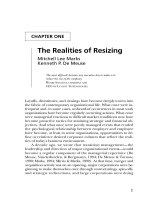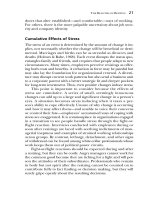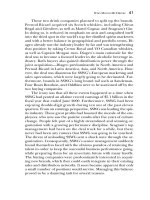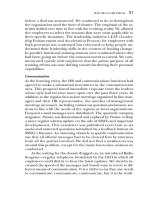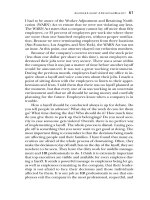Resizing The Organization 18 ppsx
Bạn đang xem bản rút gọn của tài liệu. Xem và tải ngay bản đầy đủ của tài liệu tại đây (130.65 KB, 10 trang )
1 and 2, the asset downsizers showed improvements in returns on
assets that were significantly higher than those of stable employers
and also higher than those of their industries. We conclude that
while some categories of downsizers improved their profitability
through downsizing, this effect is not sufficiently consistent across
categories to justify rejection of the null hypothesis.
The results of the regression of the change in ROA on the
change in employment provided further support for this conclu-
sion. Firms with larger increases (or smaller declines) in employ-
ment had larger increases in their returns on assets, although that
effect was very small. The same pattern of results held for the time
period 1995 to 2000.
Hypothesis 2 stated that there is no effect of changes in employ-
ment on total return on common stock in the year of the em-
ployment change and in the two succeeding years. Figure 7.5 shows
that for the 1982-to-2000 time period, only two categories of com-
panies consistently and significantly yielded higher total returns
on their common stock than stable employers: the asset and em-
ployment upsizers. However, on an industry-adjusted basis, only
the asset upsizers yielded returns that were significantly higher
than those of all other groups, including stable employers (see Fig-
ure 7.6).
The cumulative total return by the end of year 2 for a $1 in-
vestment was $1.69 for stable employers. For asset upsizers, it was
$2.42, and it was $1.99 for employment upsizers. In contrast, it
was $1.72 for employment downsizers and $1.72 for asset downsiz-
ers. The same overall pattern of results held for the 1995 to 2000
time period, as Figures 7.7 and 7.8 demonstrate.
In terms of Hypothesis 2, we reject the null and conclude that
some types of restructuring, namely, asset upsizing and employ-
ment upsizing, do produce significantly higher returns on com-
mon stock, especially by year 2 after the restructuring. However,
on an industry-adjusted basis, this conclusion holds only for asset
upsizers.
These results suggest that downsizing strategies, either em-
ployment downsizing or asset downsizing, do not yield long-term
payoffs that are significantly larger than those generated by stable
employers. The latter group includes those companies in which
the complement of employees did not fluctuate by more than ±5
FINANCIAL CONSEQUENCES OF EMPLOYMENT CHANGE DECISIONS 151
TEAMFLY
Team-Fly
®
152 RESIZING THE ORGANIZATION
percent. This conclusion differs from that in our earlier analysis of
the data from 1982 to 1994. In that study (Cascio et al., 1997), we
concluded that some types of downsizing, namely, asset downsiz-
ing, do yield higher ROAs than either stable employers or their in-
dustries. However, when the data from 1995 to 2000 are added to
the original 1982-to-1994 data, a different picture emerges. That
picture suggests clearly that at least during the time period of our
study, that it was not possible for firms to “save” or “shrink” their
way to prosperity. Rather, it was only by developing their businesses
(asset upsizing) that firms outperformed stable employers as well
as their own industries in terms of profitability and total returns
on common stock.
Managers of publicly owned firms have an obligation to run
them as efficiently as possible. Even if these firms are large and sta-
ble, managers should be searching for ways to improve profitabil-
ity, including adjusting their workforces. Yet what is striking about
the results of the downsizings is the negligible impact on firm prof-
itability relative to the size of the layoffs. The employment down-
sizers reduced their workforces by an average of 5.66 percent by
the end of year 2. Although they did increase their returns on as-
sets slightly (1/2 of 1 percent), their profitability never exceeded
that of stable employers that did not downsize. Relative to their in-
dustries, they were able to attain an ROA that was only 3/10 of 1
percent above their industry average by the end of year 2. The
combination downsizers reduced their workforces by 15.71 percent
by the end of year 2, yet showed profitability results that were little
better than those of the employment downsizers.
What are the implications of this study? Senior managers are
under considerable pressure from their stockholders to improve fi-
nancial performance. They often try to do this by cutting costs or
restructuring assets. Many managers have accepted employment
downsizing as a strategy for cutting costs in a manner that is tangible
and predictable. Does such cost cutting translate into higher prof-
its? Our research, performed at the firm level rather than at the
level of the strategic business unit, has not produced evidence that
downsizing firms were able generally and significantly to improve
profits or cumulative returns on common stock. However, the evi-
dence indicates that upsizing firms were able to please their stock-
holders, and asset upsizers generated stock returns that were
superior to those of their industries in every year after the base year.
Given these results, we conclude that downsizing may not nec-
essarily generate the benefits sought by management. Managers
must be very cautious in implementing a strategy that can impose
such traumatic costs on employees, both on those who leave as well
as on those who stay (Cascio, 1993, 2001; De Meuse et al., 1997).
Management needs to be sure about the sources of future savings
and carefully weigh those against all the costs, including potential
increased costs associated with subsequent employment expansions.
Employment Downsizing and Flexibility
This study did not directly address the issue of flexibility. However,
it is probably true that many firms increased their strategic flexi-
bility by thoughtful downsizing and asset restructuring. Many
sharpened the focus of their business by divesting business units
that did not fit with their mission. Others eliminated excess em-
ployees and cut costs to improve their competitiveness.
However, there is a paradox in the attempt to make a company
lean and mean, while maintaining the flexibility to be nimble. In
order to be nimble, a company must have the flexibility to take ad-
vantage of emerging prospects. To a great extent, flexibility de-
pends on the firm’s having some excess capacity, or slack. For
example, in order to increase production when demand increases,
a manufacturing firm needs to have some excess production ca-
pacity in its plants, and to take advantage of new investment op-
portunities, it needs unused financial resources. This need for
excess capacity applies at least as much to its people as it does to
its physical plant or financial resources. Even if the firm has the
physical and financial resources, its ability to make productive use
of those resources will be constrained by its human resources. Sim-
ply put, it needs the people to implement its plans, expansions,
and investments, particularly in the increasingly service- and
information-dominated U.S. economy. Consequently, it may be ad-
vantageous to maintain human resources even in slower periods
in order to support flexibility.
Implications for Decision Makers
Decisions about restructuring deserve the same diligent analysis
as any important capital investment decision. That is, the same
methods of capital investment analysis can and should be applied
FINANCIAL CONSEQUENCES OF EMPLOYMENT CHANGE DECISIONS 153
154 RESIZING THE ORGANIZATION
to the firm’s hiring and firing decisions as are applied to the deci-
sions to acquire or divest a plant or division. Firms should evaluate
the present value of the cash flows associated with the decision over
the full course of the business cycle and over the entire life of the
decision. With respect to layoffs, this should take account of the cost
savings in the short run, net of severance payments and outplace-
ment costs (typically 10 to 15 percent of the salaries of profession-
als and senior executives), as well as the costs of possibly having to
rebuild the workforce at a later date.
Notes
1. COMPUSTAT provides aggregate, total data for each industry based
on its Standard Industrial Classification code. Our industry ratios
are the ratios of the industry-aggregate variables. If the number of
companies in the industry is small or the data are unavailable, COM-
PUSTAT does not produce the industry-aggregate data. Stock re-
turns for the industry are equally weighted portfolios of the
companies in the industry SIC group.
2. The tables from which these data are extracted are not included to
conserve space. They are available by request from the authors. In
addition, for clarity, figures do not show results for the combination
downsizers and the combination upsizers.
References
Ansberry, C. (2001, July 6). Private resources: By resisting layoffs, small
manufacturers help protect economy. Wall Street Journal, pp. A1, A2.
Armstrong-Stassen, M. (1998). The effect of gender and organizational
level on how survivors appraise and cope with organizational down-
sizing. Journal of Applied Behavioral Science, 34, 125–142.
Ball, R., & Brown, P. (1968, Autumn). An empirical evaluation of ac-
counting income numbers. Journal of Accounting Research, 159–178.
Brockner, J. (1988). The effects of work layoffs on survivors: Research,
theory, and practice. In B. M. Staw & L. L. Cummings (Eds.), Re-
search in organizational behavior (Vol. 10, pp. 213–255). Greenwich,
CT: JAI Press.
Brockner, J., & Wiesenfeld, B. M. (1996). An integrative framework for
explaining reactions to decisions: Interactive effects of outcomes
and procedures. Psychological Bulletin, 120, 189–208.
Cascio, W. F. (1993). Downsizing: What do we know? What have we
learned? Academy of Management Executive, 7, 95–104.
Cascio, W. F. (2001, October). Strategies for responsible restructuring. Keynote
address presented at the National Manpower Summit, Singapore.
Cascio, W. F., Young, C. E., & Morris, J. R. (1997). Financial consequences
of employment-change decisions in major U.S. corporations. Acad-
emy of Management Journal, 40, 1175–1189.
De Meuse, K. P., Bergmann, T. J., & Vanderheiden, P. A. (1997). Corpo-
rate downsizing: Separating myth from fact. Journal of Management
Inquiry, 6, 168–176.
De Meuse, K. P., Vanderheiden, P. A., & Bergmann, T. J. (1994). An-
nounced layoffs: Their effect on corporate financial performance.
Human Resource Management, 33, 509–530.
DeWitt, R. L. (1993). The structural consequences of downsizing. Orga-
nization Science, 4, 30–40.
DeWitt, R. L. (1998). Firm, industry, and strategy influences on choice of
downsizing approach. Strategic Management Journal, 19, 59–79.
Elovainio, M., Kivimaki, M., & Helkama, K. (2001). Organizational jus-
tice evaluations, job control, and occupational strain. Journal of Ap-
plied Psychology, 86, 418–424.
Fisher, S. R., & White, M. A. (2000). Downsizing in a learning organiza-
tion: Are there hidden costs? Academy of Management Review, 25,
244–251.
Freeman, S. J., & Cameron, K. S. (1993). Organizational downsizing: A con-
vergence and reorganization framework. Organization Science, 4, 10–29.
Healy, P., Palepu, K., & Ruback, R. (1992). Does corporate performance
improve after mergers? Journal of Financial Economics, 31, 135–175.
Hire math: Fire 3, add 5. (2000, March 13). Business Week, p. 28.
Kaplan, S. (1989). The effects of management buyouts on operating per-
formance and value. Journal of Financial Economics, 24, 217–254.
Leana, C. R. (1996, April 14). Why downsizing won’t work. Chicago Tri-
bune Magazine, pp. 15–18.
Leana, C. R., & Feldman, D. C. (1992). Coping with job loss: How individu-
als, organizations, and communities respond to layoffs. San Francisco:
New Lexington Press.
McKinley, W. (1992). Decreasing organizational size: To untangle or not
to untangle? Academy of Management Review, 17, 112–123.
McKinley, W., Mone, M. A., & Barker, V. L. III. (1998). Some ideological
foundations of organizational downsizing. Journal of Management In-
quiry, 7, 198–212.
McKinley, W., & Scherer, A. G. (2000). Some unanticipated consequences
of organizational restructuring. Academy of Management Review, 25,
735–752.
McKinley, W., Zhao, J., & Rust, K. G. (2000). A sociocognitive interpreta-
tion of organizational downsizing. Academy of Management Review,
25, 227–243.
Mishra, A. K., & Spreitzer, G. M. (1998). Explaining how survivors
FINANCIAL CONSEQUENCES OF EMPLOYMENT CHANGE DECISIONS 155
156 RESIZING THE ORGANIZATION
respond to downsizing: The roles of trust, empowerment, justice,
and work redesign. Academy of Management Review, 23, 567–588.
Newby, A. (2001, July 23). White-collar blues. Fortune, pp. 98–110.
Ofek, E. (1994). Efficiency gains in unsuccessful management buyouts.
Journal of Finance, 46, 637–654.
Pearlstein, S. (2001, August 6). Foreign firms’ layoffs hit home for U.S.
workers. Washington Post, pp. A1, A8.
“Shadow of recession”; available at www.cbsmarketwatch.com; retrieved
February 9, 2002.
Shirouzu, N. (2000, January 5). Leaner and meaner: Driven by necessity—
and by Ford–Mazda downsizes, U.S style. Wall Street Journal, pp. A1,
A10.
Sony’s shake-up. (1999, March 22). Business Week, pp. 52, 53.
Standard & Poor’s. (2000). Standard & Poor’s research insight. New York:
McGraw-Hill.
Vanderheiden, P. A., De Meuse, K. P., & Bergmann, T. J. (1999). And the
beat goes on: Corporate downsizing in the twenty-first century.
Human Resource Management Journal, 38, 261–268.
Watts, R. (1978, June-September). Systematic “abnormal” returns after
quarterly earnings announcements. Journal of Financial Economics,
127–150.
Wayhan, V. B., & Werner, S. (2000). The impact of workforce reductions
on financial performance: A longitudinal perspective. Journal of
Management, 26, 341–363.
Weick, K. E. (1995). Sensemaking in organizations. Thousand Oaks, CA:
Sage.
Worrell, D. L., Davidson, W. N. III, & Sharma, V. M. (1991). Layoff an-
nouncements and stockholder wealth. Academy of Management Jour-
nal, 34, 662–678.
Worst-case scenario. (2001, March 26). Time, pp. 54–57.
CHAPTER 8
Resizing and the
Marketplace
The Response of Customers
and Competitors
to Reorganization
David T. Bastien
Todd J. Hostager
A critical element of organizational performance is the behavior
of competitors and customers. Ultimately, it is the customers of any
company who determine its success or failure. A major problem
for almost any organization undergoing a resizing change is that
its revenues drop, sometimes dramatically (Hughlett, 1997; Kover,
2000; Waters, 1997). Furthermore, in competitive contexts, com-
petitors of the changing organization can have an important im-
pact on the patronage of the changing organization’s customers
(Bastien, 1994; Bastien, Hostager, & Miles, 1996; Grubb & Lamb,
2000).
The other chapters in this book have established that resizing
efforts are frequently marked by a discrete set of performance
characteristics: downturns in short-term productivity, upswings in
unwanted employee turnover, upswings in production errors,
downturns in revenues and in market share, and the unwillingness
or inability of strategic decision makers to anticipate these mark-
ers. Each of these markers can have a serious impact on customers,
making a customer’s patronage more expensive in a number of
157
158 RESIZING THE ORGANIZATION
ways. Customers of any competitive enterprise always have choices,
and their patronage decisions do not involve stakes as high as those
faced by employees, managers, or shareholders of the resizing com-
pany. In other words, when customers face changing or unhappy
contact people, defective products or poor service, slowed delivery
or changes in delivery terms, or any other new customer routine,
it may be easier and cheaper to change vendors.
Over the years of research on resizing changes in all their va-
rieties, little attention has been focused on customers’ reactions to
resizing change and the competitive response to resizing by rivals.
In some measure, this inattention is due to the difficulty in gath-
ering data directly from customers. For example, resizing compa-
nies are reluctant to allow researchers access to their customers,
rivals are equally reluctant, and the customers often are difficult
to identify and access. This has resulted in only a few studies in ad-
dition to the case data and anecdotal data in the literature.
In this chapter, we explore the reactions of customers and com-
petitors to resizing change as explained in the literature and as is
visible in the press. Then we present a study of customer and com-
petitor behavior in a resizing context, and integrate the literature
with the study results to develop a set of guidelines for resizing
managers who are trying to maintain revenues and market share
while resizing.
The Literature on Customers and
Competitors of Resizing Firms
Most of the other chapters in this book have looked at resizing as
downsizing, but many other strategies involve resizing as well. For
instance, mergers and acquisitions (M&As) and reorganizations
frequently are justified by the notion that administrative costs can
be decreased while increasing production, operational, or distrib-
ution capacity. In other words, the downsizing dimension of resiz-
ing is embedded in a growth dimension. Thus, the organizational
performance dynamics associated with M&As, reorganizations, au-
tomation, and downsizing as described in the literatures relating
to those strategies must be outlined, especially those dynamics
likely to have some impact on customers.
First, it is often noted that the process of implementing resiz-
ing change is where many problems occur. Marks and Mirvis
(1985) identified a pathological syndrome (see Table 8.1) that is
more or less universally observed in M&As, downsizing, and other
forms of resizing changes. This syndrome focuses on internal dy-
namics, including high levels of personal uncertainty about expected
performance and behavior; increased attention to behavior of the
top management; increased needs for communication and infor-
mation with a tendency toward worst-case rumor generation in the
absence of hard information; and strong resentment of the behav-
ior of the acquiring organization’s managers. On an organizational
RESIZING AND THE MARKETPLACE 159
Table 8.1. Common Responses
to Mergers and Acquisitions.
Responses at the Individual Level
Personal uncertainty about
expected performance and
behavior
Increased needs for receiving
communication and information,
combined with a decreased
willingness to give information
Heightened attentiveness to
communication from higher
organizational levels, especially
from the acquiring company
management
Simultaneous fight-or-flight
response by employees and
managers
Resistance to change
Culture shock
Focus on personal security rather
than organizational goals
Job searches by acquired company
employees and managers
Cultural differences reported as a
source of hostility and conflict,
including resentment of
acquiring company managers
Responses at the Organizational Level
Tendency toward rumor mills in the
absence of hard information,
with the rumors carrying worst
case prophecies
Levels and units isolate themselves
from horizontal and vertical
communication channels inside
the organization, leading to
information constipation
High rates of unwanted turnover
among employees and managers,
especially on the acquired side
Generalized decline in
organizational performance
manifest by decreased earnings,
profits, and productivity
Source: Based on Bastien, 1989.
160 RESIZING THE ORGANIZATION
level, these same studies noted the following common phenomena:
(1) a tendency not to pass news of problems either up or down; a
tendency among top management on both sides not to communi-
cate with their respective organizations about the resizing; (2) a
tendency toward high rates of unwanted turnover; (3) conflict
within the acquired organization or between the participating or-
ganizations, often quite intense; and (4) a tendency toward a de-
crease in earnings and productivity (Cameron, Whetten, & Kim,
1987; Cascio, 1998; Cascio, Young, & Morris, 1997; De Meuse, Van-
derheiden, & Bergmann, 1994; Vanderheiden, De Meuse, & Berg-
mann, 1999).
A number of other authors have confirmed and expanded on
this change syndrome (Bastien, 1987, 1989; Buono & Bowditch,
1989; Burke & Nelson, 1998; Campbell, Goold, & Alexander, 1995;
Cascio, 1993, 1995; Geneen & Bowers, 1999; Jick, 1985; Leana &
Feldman, 1992; Marks, 1994; Noer, 1993; Sirower, 1997; Zweig,
Kline, Forest, & Gudridge, 1995). Bastien, McPhee, and Bolton
(1995), in examining a reorganization of a municipal government
following the election of a new mayor, found that the syndrome as
described by Mirvis and Marks (1986) exemplified the dynamics
in their reorganization case. O’Neill and Lenn’s study of middle
managers in a downsized organization (1995) revealed high levels
of anger, resentment, resignation, anxiety, and cynicism. Blundell
(1978) interviewed government employees whose staff had been
downsized and reorganized and found that fear and uncertainty
about the future produced declines in productivity.
Many authors have pointed out that organizational culture is
an important source of problems in resizing efforts (Ambrose,
1998; Bastien, 1989, 1994; Cartwright & Cooper, 1996; Clemente
& Greenspan, 1998; Galpin & Herndon, 1999; Haspeslagh & Jemi-
son, 1991; Lajoux, 1997; Marks, 1994; Marks & Mirvis, 1998; Mirvis
& Marks, 1992). They have reported that the process of change not
only creates a negative effect in the changing organization but also
involves a slowdown of organizational and operational process that
must affect customers. Furthermore, the process of change gen-
erates errors, again affecting customers. Cameron, Freeman, and
Mishra’s study of downsizing in the U.S. automobile industry
(1991) revealed widespread implementation efforts and decreased
levels of quality, productivity, and effectiveness.

